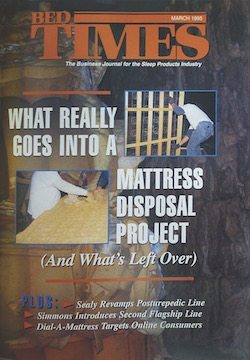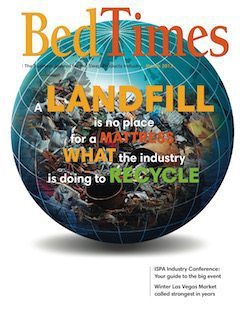The International Sleep Products Association’s first 100 years—Part V of the fourth and final installment
Putting old beds to bed: Mattress Recycling success comes from ‘try, try again’ determination
There’s nothing the mattress industry likes better than selling beds (except perhaps selling beds at higher price points). But selling new mattress sets always has had an attendant problem: What do you do with the old ones?

In 1991, the International Sleep Products Association’s Disposal Task Force surveyed 154 retailers operating in 54 areas of the United States to determine what was happening to bedding at the end of its useful lifecycle, according to an article in the June 1991 issue of BedTimes magazine. The results were encouraging—in the sense that they confirmed the real need for better ways to dispose of mattresses:
✦ Nearly 70% of retailers said they sent used bed sets they collected from customers’ homes to landfills. Another 30% said they gave all or some of the used bedding to charities and 16% sent old bed sets to renovators. (Numbers don’t add up to 100% because respondents could give more than one answer.)
✦ Some 60% of retailers said they faced problems such as limited landfill space, rising fees and new landfills that were more expensive or difficult to access.
In 1992, ISPA sponsored an experimental program in Baltimore to turn old mattresses and foundations into energy. The heavily promoted test—which had the financial support of 10 brand-name mattress manufacturers, as well as other groups—hoped to convert 10,000 mattresses into tens of thousands of volts of energy at the city’s waste-to-energy facility. Only 800 mattresses were collected from consumers’ homes.

That sentiment sums up many of the industry’s early attempts at mattress disposal: Try, try again until something works.
In 1994, a new project—though one in the works for nearly a decade—got off the ground when the U.S. Department of Justice’s Federal Prison Industries finally agreed to work with the bedding industry on a joint mattress disposal project.
“By October, prisoners at the Federal Correctional Institution in Fairton, New Jersey, were tearing down mattresses delivered to the prison by surrounding area retailers,” according to an article in the December 1994 issue of the magazine.
“Though the project is off to a promising start (more than 100 mattresses per day are being torn down and retailer interest in contributing mattresses is growing), ISPA continues to work to develop a market for used components.”
The problem of finding markets for components would scuttle the prison project, which was unable to pay for itself—and stymie industry recycling efforts for a decade to come.
Meanwhile, some companies pursued their own initiatives. For instance, in 1994, Verlo Mattress Co. in Whitewater, Wisconsin, created the National Outcycle Environmental Program to process mattresses taken in through the factory-direct’s retail locations. It was not a cheap endeavor: By 1997, Verlo had invested $650,000 in the program, which wouldn’t operate in the black until 2000, according to a BedTimes article in February 2001.
During the coming years, the industry’s recycling efforts were helped along by a number of factors. First, pressure on landfill capacities drove up tipping fees, and governments began banning entire classes of products from being dumped in them. Local officials also started mandating household recycling programs that made consumers more comfortable with and aware of the benefits of recycling. And, importantly, the market for recyclable components eventually grew stronger, driven, in part, by increasing global demand for raw materials.

St. Vincent de Paul was a pioneer, opening DR3 in Oakland, California, in 2000. Not long after, Conigliaro Industries, a private recycling company, launched an operation in Framingham, Massachusetts. Throughout the 2000s, new nonprofit and for-profit recyclers opened or expanded their operations. In 2015, there were more than 50 recyclers accepting and processing mattresses in the United States and Canada. (Find a recycler using this mattress recycling facilities locator.)
State laws change the game
Around 2011, a number of states began considering “extended producer responsibility” legislation that would hold mattress manufacturers responsible for the disposal of their products at the end of their useful lives. ISPA opposed the proposed laws, arguing that the requirements would significantly drive up costs for the entire industry and be unduly burdensome.
The association worked instead with state lawmakers, local governments, manufacturers, retailers, suppliers and other stakeholders to craft more workable frameworks. In 2013, lawmakers in California, Connecticut and Rhode Island passed mattress-recycling laws that ISPA supported. The laws require any company that sells mattresses or foundations in those states to collect a small fee on every piece, with that money then used to fund recycling efforts. Fees are reasonable: Around $9 to $11 per piece in the three states.
Connecticut’s program went into effect in May 2015 and, in the first five months, recycled nearly 50,000 mattresses. The program in California is expected to begin in late December 2015, with the one in Rhode Island to start in early 2016.

“We want to work with the retailers to make the mattress-recycling fee and programs positive,” said Ryan Trainer, president of both ISPA and MRC, in a BedTimes article in August 2014. “We, as an industry, have a good story to tell about mattress recycling and the environment. Recycling keeps mattresses out of the landfills and off the roadsides.”
View this special section as it appears in the print magazine: BedTimes November digital edition.
Read previous chapters in the 100-year history of ISPA:
1915-1940: An industry comes together
1941-1965: A time of war, a time for peace
1966-1990: The challenge of change
Read all five sections of this special ISPA 1991-2015 feature:
Part I – Main feature: Mattress Industry Booms and Busts
Part II – Specialty Sleep Mattresses Go Mainstream
Part III – Interzum, Las Vegas Market Shopping Venues Open
Part IV – Better Sleep Council Shifts Message
Part V – Mattress Recycling History
Or, read Parts I-V in the November BedTimes Digital Edition.




